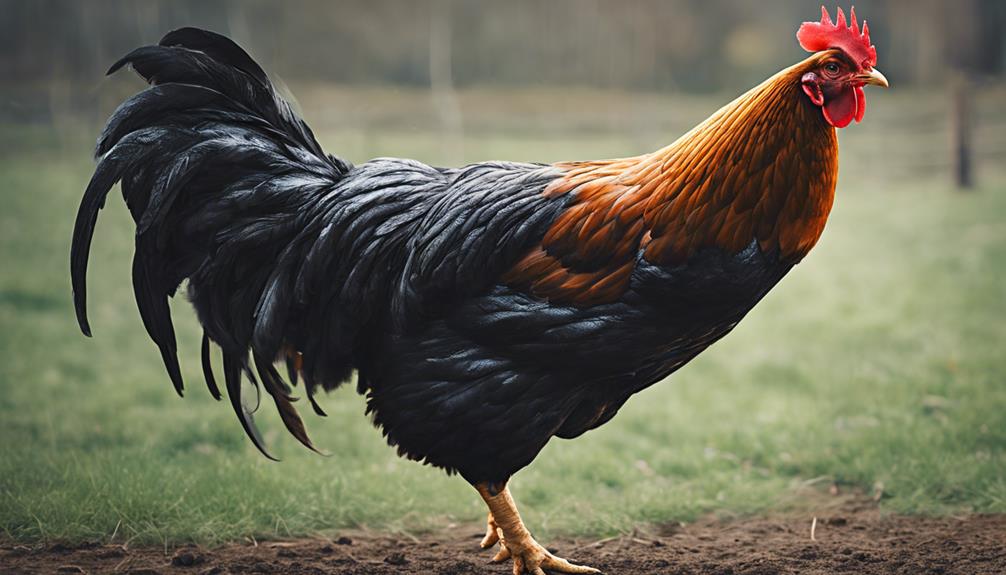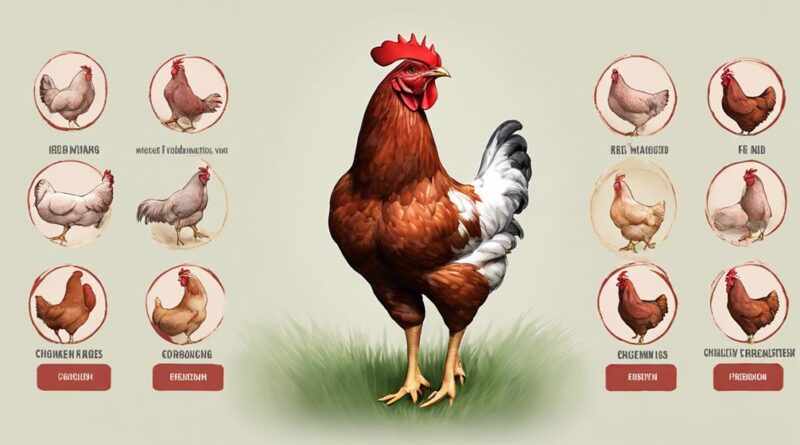7 Best Chicken Breeds for High-Quality Meat Production
When considering the best chicken breeds for high-quality meat production, you might wonder what sets these 7 breeds apart from the rest. Each breed brings its own unique advantages to the table, whether it's the rapid growth of the Cornish Cross or the robust build of the Jersey Giant. These breeds have been carefully selected and bred to excel in meat production, but what specific characteristics make them top choices for meat enthusiasts? Let's explore the key traits and benefits that make these chicken breeds stand out in the world of high-quality meat production.
Cornish Cross
When raising Cornish Cross chickens for meat production, it's crucial to understand their rapid growth rate and specific dietary requirements. Cornish Cross chickens are renowned for their exceptional growth rate and efficient feed conversion. They're typically ready for processing in just 6-8 weeks due to their rapid development, making them a popular choice for meat production.
In terms of growth rate, Cornish Cross chickens are unmatched in the industry. They exhibit impressive weight gain, often reaching 4-5 pounds in just a few weeks. This rapid growth necessitates careful monitoring of their diet to ensure they receive adequate nutrition without becoming overweight or developing health issues.
Moreover, Cornish Cross chickens have been selectively bred for meat production, focusing on traits that enhance their growth potential. While their growth rate is a significant advantage, it's essential to provide them with a balanced diet to support their development adequately.
When it comes to health and disease resistance, Cornish Cross chickens may be more susceptible to certain conditions due to their accelerated growth. Therefore, maintaining a clean environment, providing access to fresh water, and monitoring their health regularly are crucial aspects of raising these birds for meat production. By staying attentive to their specific needs, you can ensure the well-being and productivity of your Cornish Cross chickens.
Sussex
The Sussex chicken breed is recognized for its dual-purpose capabilities in meat and egg production, making it a valuable addition to any poultry operation. When it comes to breeding techniques, Sussex chickens are known for their natural ability to reproduce and thrive in various environments. They're often bred using traditional methods that focus on selecting individuals with desirable traits such as fast growth rate, good meat quality, and consistent egg production.
In terms of nutritional requirements, Sussex chickens need a well-balanced diet to support their growth and productivity. A diet high in protein is essential for meat production, while also ensuring they receive adequate vitamins and minerals for overall health. Providing access to fresh water at all times is crucial to prevent dehydration, especially during hot weather or when they're laying eggs.
When raising Sussex chickens for meat production, it's important to monitor their growth closely and adjust their diet accordingly to meet their changing nutritional needs. By following proper breeding techniques and providing the necessary nutritional requirements, Sussex chickens can reach their full potential in both meat and egg production, making them a top choice for farmers looking to maximize their poultry operation's output.
Orpington
Orpington chickens, known for their robust build and excellent meat quality, are a popular choice for meat production due to their rapid growth and efficient feed conversion rates. When considering the Orpington breed for meat production, it's essential to understand some key characteristics that set them apart:
- Orpington Breed Characteristics:
- Orpington chickens are known for their large size and heavy bodies, making them ideal for meat production.
- They've a broad, deep body with a well-rounded breast, providing ample meat yield.
- Orpingtons come in various colors, including black, blue, buff, and white, adding aesthetic appeal to meat production operations.
When comparing the meat quality of Orpington chickens to other breeds, several factors come into play:
- Orpington Meat Quality Comparison:
- Orpington meat is known for its tenderness and succulence, making it a preferred choice for high-quality meat products.
- The meat-to-bone ratio in Orpington chickens is favorable, resulting in more meat per bird compared to some other breeds.
- Orpington meat is flavorful and juicy, enhancing the overall dining experience for consumers.
Wyandotte
Moving on to the Wyandotte breed, known for its distinctive appearance and versatility in meat production, these chickens offer a unique set of characteristics that make them a valuable choice for meat farmers. When it comes to Wyandotte breeding techniques, selecting birds with desired traits like fast growth, efficient feed conversion, and good meat-to-bone ratio is crucial. Wyandottes are known for their excellent meat quality characteristics, such as tender and flavorful meat with a good texture. To enhance these qualities, breeding practices often focus on maintaining the breed's robustness while improving its meat production traits.
Wyandottes are a dual-purpose breed, valued for both their meat and egg-laying abilities. Their ability to produce high-quality meat makes them a popular choice among poultry farmers looking for efficient meat production. When raising Wyandottes for meat, it's essential to provide them with a balanced diet rich in protein to support their growth and development. Additionally, ensuring they've access to adequate space and proper housing conditions is vital for their overall well-being and meat quality.
Brahma
Known for their impressive size and gentle temperament, Brahma chickens are a popular choice for meat production among poultry farmers. If you're considering raising Brahma chickens for meat, understanding their characteristics and care requirements is crucial:
- Brahma Characteristics:
- Size: Brahma chickens are one of the largest chicken breeds, with roosters weighing around 12 pounds and hens around 9.5 pounds. Their size contributes to their reputation as a meat breed.
- Feathered Legs: One distinctive feature of Brahmas is their feathered shanks and toes, which give them a unique appearance. However, this also means they require extra care to keep their feathers clean and free from mites.
- Docile Nature: Brahmas are known for their calm and friendly temperament, making them easy to handle and manage. This gentle nature makes them suitable for backyard settings or small farms.
When it comes to Brahma care requirements, there are a few essential aspects to consider:
- Housing: Provide spacious and secure housing for Brahma chickens due to their large size. Ensure good ventilation and protection from extreme weather conditions.
- Feeding: Offer a balanced diet rich in protein to support their growth for meat production. Brahmas have a hearty appetite, so make sure they've access to adequate feed at all times. Additionally, provide fresh water regularly to keep them healthy and hydrated.
Rhode Island Red
Rhode Island Red chickens, renowned for their prolific egg-laying capabilities and adaptable nature, are a popular choice for both backyard enthusiasts and commercial egg production farms. This breed is considered a dual-purpose breed, excelling not only in egg production but also in meat quality. When it comes to egg production, Rhode Island Reds are consistent layers of large brown eggs, averaging around 200-300 eggs per year. Their eggs are known for their rich flavor and sturdy shells, making them a favorite among farmers and consumers alike.
In addition to their impressive egg-laying abilities, Rhode Island Reds are valued for their meat production qualities. While they aren't as large as some specialized meat breeds, their meat is flavorful and of high quality. The birds grow relatively quickly and have well-developed breasts, making them a good choice for those looking to raise chickens for both eggs and meat. Their dual-purpose nature makes them a practical option for those with limited space or resources who want to maximize the productivity of their flock.
Jersey Giant

With its impressive size and robust build, the Jersey Giant chicken breed is recognized for its significant contribution to meat production in the poultry industry. Here are some key points to consider when raising Jersey Giants:
- Growth Rate: Jersey Giants are known for their rapid growth rate, making them an excellent choice for meat production. These birds reach market weight relatively quickly compared to other breeds, typically reaching around 8-9 pounds for males and 6-8 pounds for females within 6-7 months.
- Feeding Requirements: To support their rapid growth, Jersey Giants require a high-quality diet rich in protein. A diet consisting of 18-22% protein is recommended for optimal growth and development. Supplementing their diet with vitamins and minerals can also help ensure they reach their full potential.
- Careful Monitoring: Due to their size and growth rate, it's essential to monitor Jersey Giants regularly to prevent obesity and other health issues. Providing ample space for exercise and ensuring access to clean water at all times is crucial for their overall well-being.
Frequently Asked Questions
Can These Chicken Breeds Be Raised in Urban Areas?
When considering raising chicken breeds in urban areas, you must account for space constraints and design a suitable coop that fits the available area.
It's crucial to adhere to noise regulations to minimize community impact. Ensuring that the coop design is efficient and compact can help mitigate noise and space issues.
What Is the Average Lifespan of These Chicken Breeds?
The average lifespan of these chicken breeds varies depending on genetic factors and management practices. Proper care, nutrition, and environment play a significant role in how long they live.
Factors such as stress, disease prevention, and overall health can impact their longevity. By providing a suitable environment and following recommended management practices, you can help ensure that these chicken breeds live a healthy and fulfilling life.
Do These Breeds Require Special Dietary Considerations?
When raising chickens for meat, it's crucial to understand their feeding requirements. Different breeds may have specific nutritional needs to support optimal growth rates and feed efficiency. Monitoring their diet closely ensures they receive the necessary nutrients for healthy development.
Consider factors like protein content, vitamins, and minerals when planning their meals. By tailoring their diet to meet these requirements, you can help them grow into high-quality meat producers.
Are These Breeds Prone to Any Common Health Issues?
Common health issues can affect chickens regardless of breed. To safeguard your flock, implement preventive measures like regular vaccinations and proper hygiene.
When selecting breeds, consider genetic predispositions to certain diseases. Management practices, such as providing a clean environment and balanced nutrition, can enhance disease resistance.
Understanding breed-specific vulnerabilities can help you develop a proactive health plan for your chickens.
How Do These Breeds Compare in Terms of Egg Production?
When comparing chicken breeds for egg production, you'll find variations in the number and quality of eggs laid. Factors like genetics and breeding influence these differences.
Some breeds are known for higher egg yields, producing more eggs per week. Additionally, the nutritional value of the eggs can vary depending on the breed.
Understanding these differences can help you select the right breed for your specific egg production needs.
Conclusion
In conclusion, the 7 best chicken breeds for high-quality meat production are the Cornish Cross, Sussex, Orpington, Wyandotte, Brahma, Rhode Island Red, and Jersey Giant. These breeds offer exceptional growth rates, meat quality, and dual-purpose capabilities.
By providing proper care, monitoring their growth, and ensuring a well-balanced diet, these breeds can thrive and yield top-quality meat for consumption. Consider these breeds for your meat production needs to achieve optimal results.
